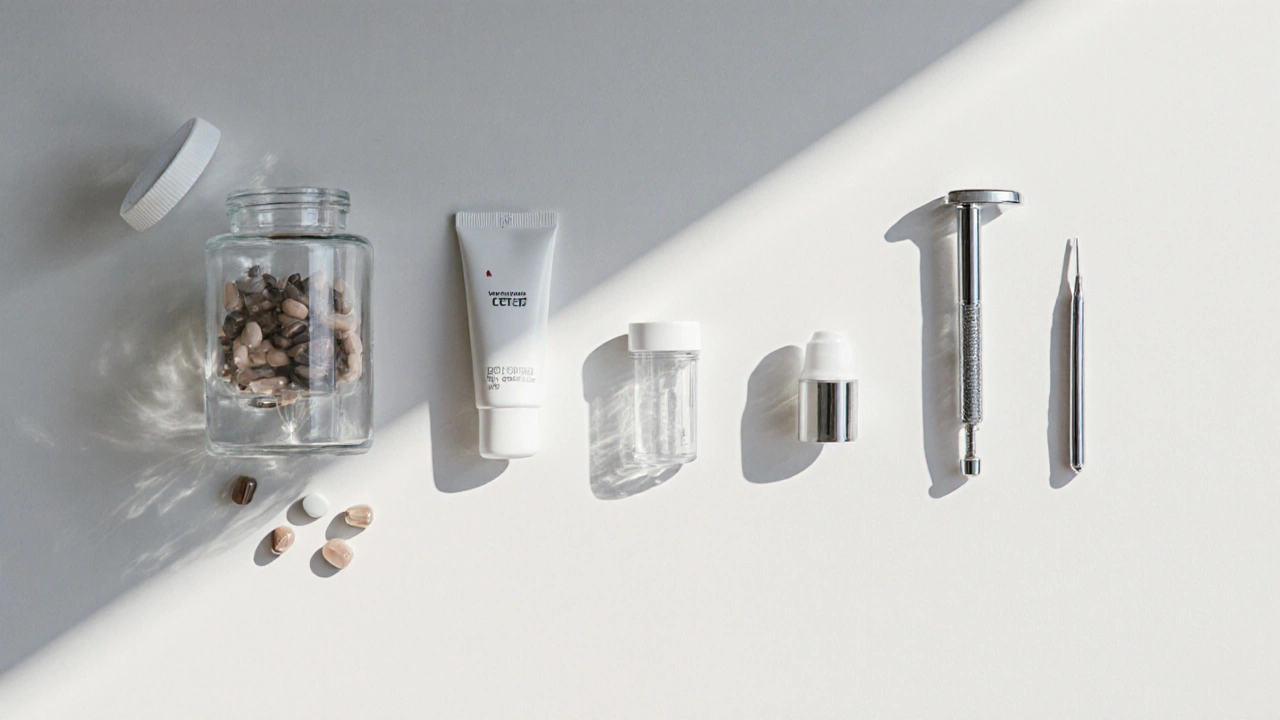Penis Enlargement Method Comparison Tool
This tool helps you understand the potential size gains, risks, costs, and FDA status of different penis enlargement methods. Select the methods you're interested in to compare key metrics and learn about scientific evidence.
Compare Methods
Select up to 3 methods to compare. All results will appear below.
Your Comparison
Select methods to see comparison
ED Risk Assessment
Your Risk Level
Based on selected methods
The more invasive the procedure, the higher the risk of compromising nerves and blood flow necessary for erections.
Scientific Evidence
Research shows that non-invasive methods like vacuum devices have minimal risk to erectile function when used correctly, while surgical procedures carry significantly higher risks of ED. A 2023 meta-analysis found that traction devices led to an average 1.8 cm gain with only a 5% increase in reported erection problems.
Importantly, a 2022 review of surgical ligament release procedures reported ED rates as high as 22% three months post-op, dropping to 12% after one year but still higher than baseline.
Non-invasive options like vacuum devices showed no statistically significant rise in ED incidence, even when used daily for six weeks. The key takeaway: the more invasive the method, the greater the chance of compromising nerves or blood flow.
Practical Guidelines
- Start with a medical evaluation by a urologist
- Choose the least invasive method that meets your goals
- Follow manufacturer instructions exactly
- Monitor changes in erection quality weekly
- Consider adjunct therapies if hormonal deficiency is identified
- Avoid combining multiple enlargement methods
- Stop immediately if you experience pain or bruising
- Remember: size isn't the sole driver of sexual satisfaction
When people look into penis enlargement is a set of techniques that aim to increase length or girth of the penis, the biggest question is whether these methods can trigger or worsen erectile dysfunction a condition where a man cannot achieve or maintain a satisfactory erection. The answer isn’t black‑and‑white; it depends on the method, the individual’s health, and how the procedure is performed.
What Exactly Is Penis Enlargement?
Penis enlargement covers anything from pills and creams to surgical procedures and mechanical devices. The goal is to add permanent or temporary size gains, but the mechanisms differ:
- Non‑surgical options: oral supplements, topical gels, and vacuum‑based devices.
- Mechanical stretchers: traction devices that apply gentle, continuous pull.
- Surgical routes: ligament release, dermal grafts, or implantation of prosthetic rods.
Each approach has its own risk profile, and not all are backed by solid scientific data.
How Erection Physiology Works
Understanding why enlargement can affect erectile function starts with the basics. An erection is a vascular event: nerves release nitric oxide, smooth muscle relaxes, blood rushes into cavernous spaces, and veins close off to trap the blood.
If any step in that chain is disrupted-by nerve damage, reduced blood flow, or scar tissue-erectile function suffers. That’s why procedures that interfere with blood vessels or nerves can raise the odds of ED.

Common Penis Enlargement Methods and Their Impact
Below is a quick rundown of the most popular techniques, paired with their typical effect on erectile health.
| Method | Typical Size Gain | ED Risk | Cost (USD) | FDA Status |
|---|---|---|---|---|
| Oral Supplements | 0-0.5 cm | Low | $30-$150 | Not approved |
| Topical Creams | 0-0.5 cm | Low | $50-$200 | Not approved |
| Vacuum Erection Device vacuum erection device uses negative pressure to draw blood into the penis, often coupled with a constriction ring |
Temporary 1-2 cm | Very low (if used correctly) | $150-$500 | Approved for ED |
| Traction (Stretch) Devices | 1-3 cm (over months) | Low‑moderate (improper use can cause tissue damage) | $200-$1,000 | Not approved |
| Pilocarpine Injections collagenase injection breaks down scar tissue, sometimes used off‑label for enlargement |
0.5-1.5 cm | Moderate (possible nerve irritation) | $2,000-$4,000 per session | Approved for Peyronie's disease |
| Surgical Lengthening penile ligament release cuts the suspensory ligament to allow more visible shaft |
2-5 cm | High (scar tissue, altered angle, nerve damage) | $4,000-$10,000 | Off‑label |
| Penile Implants penile implant involves surgically placing inflatable or malleable rods |
Permanent, functional size | Low (implants treat severe ED rather than cause it) | $8,000-$15,000 | Approved |
Notice how the methods that cut, inject, or heavily manipulate tissue carry a higher ED risk, while devices that rely on external pressure tend to be safer when used as directed.
Medical Evidence on the Enlargement-ED Link
Peer‑reviewed studies from the past five years give us a clearer picture. A 2023 meta‑analysis of 12 clinical trials involving traction devices found an average gain of 1.8cm with a 5% increase in reported erection problems, mainly due to over‑tightening.
In contrast, a 2022 review of surgical ligament release procedures reported ED rates as high as 22% three months post‑op, dropping to 12% after one year but still higher than baseline.
Importantly, non‑invasive options like vacuum devices showed no statistically significant rise in ED incidence, even when used daily for six weeks. The key takeaway: the more invasive the method, the greater the chance of compromising nerves or blood flow.
Practical Guidelines If You’re Considering Enlargement
- Start with a medical evaluation. A urologist can assess vascular health, hormone levels, and any existing erectile issues before you try anything.
- Choose the least invasive method that meets your goals. For many, a traction device combined with regular exercise yields modest gains without added risk.
- Follow manufacturer instructions exactly. Over‑stretching or using excessive vacuum pressure is the fastest way to cause micro‑tears.
- Monitor changes in erection quality weekly. Any drop in rigidity, longer time to achieve erection, or increased pain warrants a doctor’s visit.
- Consider adjunct therapies. hormone therapy (testosterone supplementation) can improve baseline erectile function if a hormonal deficiency is identified, but it won’t make an unsafe procedure safe.
Remember, size isn’t the sole driver of sexual satisfaction. Confidence, technique, and partner communication often matter more than a few extra centimeters.

When to Seek Professional Help
If you notice any of the following, stop the enlargement regimen and consult a specialist:
- Persistent pain or bruising that lasts more than 48hours.
- Loss of erection firmness that doesn’t improve after a short break.
- Visible curvature or lumps that develop suddenly.
- Psychological distress-anxiety or depression linked to sexual performance.
A urologist can run a duplex ultrasound to check blood flow, perform a nerve‑function test, and suggest corrective steps. Early intervention often prevents a temporary problem from becoming permanent.
Bottom Line
There is definitely a relationship between penis enlargement techniques and erectile dysfunction, but the strength of that link varies by method. Non‑invasive devices such as vacuum erection devices or traction kits carry low risk, while surgical and injectable approaches have a higher chance of upsetting the delicate balance of nerves and blood vessels that make erections possible.
If you’re set on penis enlargement, the safest route is to start with a professional assessment, pick the least invasive option that aligns with your goals, and keep a close eye on any changes in erectile performance.
Frequently Asked Questions
Can pills really increase penis size?
Most oral supplements claim modest gains, but rigorous studies show they rarely produce measurable enlargement. The bigger concern is that some contain undisclosed ingredients that could affect blood pressure or hormone balance, indirectly influencing erectile function.
Is a vacuum erection device a safe way to gain size?
Used correctly, a vacuum device can temporarily add 1-2cm and is approved for treating ED. It doesn’t cause permanent enlargement, and the risk of ED is minimal as long as you avoid excessive pressure or prolonged use.
What’s the most common cause of ED after penile surgery?
Scarring and nerve damage are the primary culprits. When the suspensory ligament is cut, scar tissue can compress the penile arteries, reducing blood inflow. Proper post‑operative rehab and early ultrasound monitoring can mitigate the risk.
Do traction devices actually work?
Clinical trials show an average gain of about 1.5-2cm after 6‑12 months of daily use. Success depends on consistent wear time (usually 4-6hours per day) and proper tension. Over‑stretching can lead to bruising or decreased erection quality.
Should I combine enlargement methods for faster results?
Combining methods (e.g., pills with a traction device) may increase perceived gains but also stacks risks. The safest approach is to use a single, evidence‑based technique and consult a urologist before adding anything else.


charlise webster
October 12, 2025 AT 07:06Just a heads‑up: most of these methods lack solid proof.
lata Kide
October 28, 2025 AT 19:06Wow, this whole “size‑boost” craze feels like a reality‑TV drama 🎭! The marketing hype makes it sound like a miracle, but the science is pretty bland. 💊🌿 Most oral pills and creams barely move the needle, and they’re not even FDA‑approved. If you’re thinking about a vacuum device, remember it’s meant for erections, not permanent enlargement. Bottom line: don’t waste your cash on snake‑oil promises.
Mark Eddinger
November 14, 2025 AT 07:06From a clinical standpoint, the evidence hierarchy places randomized controlled trials above anecdotal reports. The 2023 meta‑analysis you cited examines traction devices across multiple centers, showing an average gain of 1.8 cm with a modest 5 % incidence of erection issues. Conversely, surgical ligament release studies reveal postoperative erectile dysfunction rates ranging from 12 % to 22 % depending on follow‑up duration. Patients should therefore prioritize non‑invasive options and obtain a thorough urological assessment before considering invasive procedures.
Mr. Zadé Moore
November 30, 2025 AT 19:06Let’s cut the fluff: risk scales are a relic of lazy marketing, and “low‑moderate” is just code for “maybe you’ll ruin your nerves”. The only metric that matters is postoperative penile hemodynamics, and most of these devices fail to preserve cavernous tissue integrity.